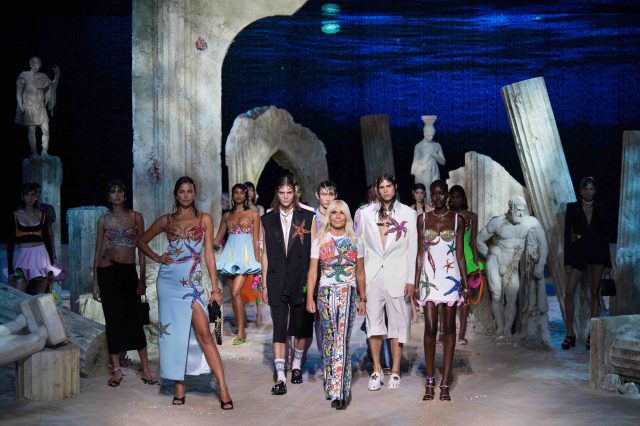It is as if Milan—one of the earliest and hardest hit cities by the pandemic, though cases are mostly holding steady now—collectively settled on minimalism as the way forward for spring 2021. Then along came Domenico Dolce and Stefano Gabbana, who decidedly did not.
An Instagram post set the scene for those of us watching from home. The short clip revealed that the Metropol, D&G’s longtime show venue, had been transformed with bright collages of print—runway, walls, benches, and all. The hashtag #DGSicilianPatchwork further spelled out the season’s theme, which the designers elaborated on in a video message. “Given our long experience being inspired by Sicily, we wanted to tell of all that you can find on an island like this, the different cultures that dominated, from the Spanish to the Arabs [to] the Normans,” said Dolce, who was born and raised there. “We’ve treasured everything that they have brought to us,” Gabbana added. “And we put it all together.”
The 90-some looks that walked the Metropol runway were less of a lesson in Sicily’s patchwork past than they were a primer in Dolce & Gabbana’s own history, of course. The hourglass dresses and sharply cut jackets pieced together from squares of brocade, chiffon, georgette, and cotton, among other materials, have long numbered among the duo’s can’t-fail silhouettes. No one looking at this collection would mistake the shirred minidress in a mashup of polka dots and florals or the bustiers and bra tops in checkerboard black and white for any label other than D&G. The designers’ command of their signatures is key to their success.
In that video recording, Dolce and Gabbana remembered a 1993 show in which they used similar patchworking techniques, only for different ends. That long-ago collection was inspired by the bohemian 1970s, a popular reference in the early ’90s. No hippie flashback, this outing was attuned to the present day. There’s no way around how hard this COVID-19 year has been for fashion brands—from creative leads and CEOs on down to patternmakers and seamstresses. Like their crochet collection of last February—which looks more and more prescient in the rearview mirror—this one puts the emphasis on fatta a mano, on Italian craftsmanship.
“The important thing to us is that each piece is interpreted by skilled hands, one after the other, and in that way each has its own character, its own story, its own passion, its own vision,” said Dolce. “From this comes the uniqueness of each piece.” But this wasn’t just a tribute to the talented craftspeople behind the clothes. In the individual looks and in the collection as a whole there was timely symbolism, a sartorial acknowledgment from a brand that has been charged with cultural insensitivities in its own past, that in this time of global crisis we are stronger together—that this is a moment for unity and bonding, not coming apart. The fact that they messaged this by exploring their own heritage only makes it more potent. As for the long dresses of many colours and prints at the end of the show? Hope and optimism aplenty.
Editor
Nicole Phelps

